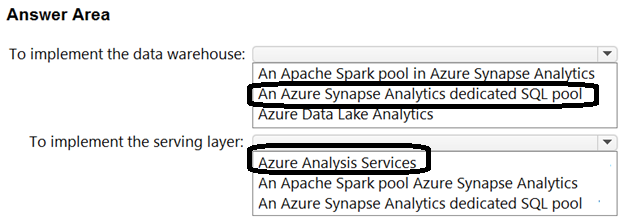Free Dumps, Free Microsoft Dump
Free AZ-305 Dump
Question #21Topic 2
HOTSPOT
–
You are planning an Azure Storage solution for sensitive data. The data will be accessed daily. The dataset is less than 10 GB.
You need to recommend a storage solution that meets the following requirements:
• All the data written to storage must be retained for five years.
• Once the data is written, the data can only be read. Modifications and deletion must be prevented.
• After five years, the data can be deleted, but never modified.
• Data access charges must be minimized.
What should you recommend? To answer, select the appropriate options in the answer area.
NOTE: Each correct selection is worth one point.
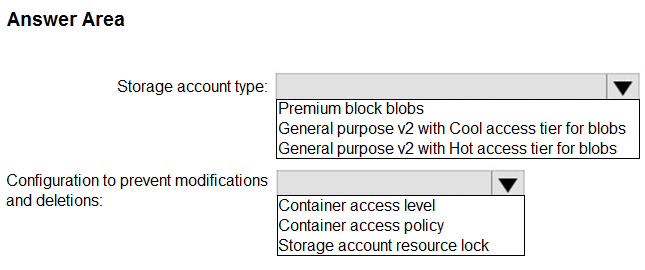
Correct Answer: 
Question #22Topic 2
HOTSPOT
–
You are designing a data analytics solution that will use Azure Synapse and Azure Data Lake Storage Gen2.
You need to recommend Azure Synapse pools to meet the following requirements:
• Ingest data from Data Lake Storage into hash-distributed tables.
• Implement query, and update data in Delta Lake.
What should you recommend for each requirement? To answer, select the appropriate options in the answer area.
NOTE: Each correct selection is worth one point.
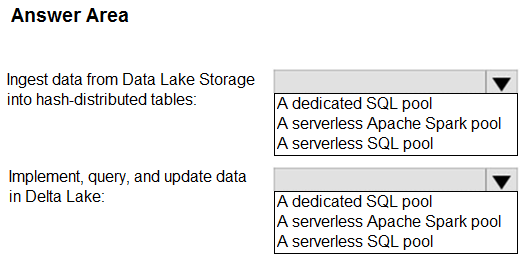
Correct Answer: 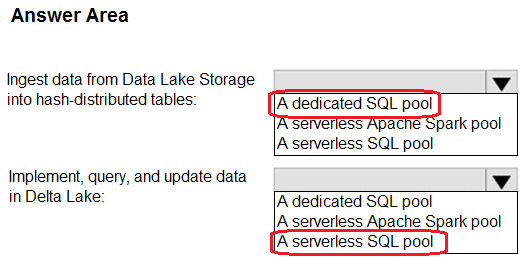
Question #23Topic 2
You have an on-premises storage solution.
You need to migrate the solution to Azure. The solution must support Hadoop Distributed File System (HDFS).
What should you use?
- A. Azure Data Lake Storage Gen2
- B. Azure NetApp Files
- C. Azure Data Share
- D. Azure Table storage
Correct Answer: A
Community vote distribution
A (100%)
Question #24Topic 2
DRAG DROP
–
You have an on-premises app named App1.
Customers use App1 to manage digital images.
You plan to migrate App1 to Azure.
You need to recommend a data storage solution for App1. The solution must meet the following image storage requirements:
• Encrypt images at rest.
• Allow files up to 50 MB.
• Manage access to the images by using Azure Web Application Firewall (WAF) on Azure Front Door.
The solution must meet the following customer account requirements:
• Support automatic scale out of the storage.
• Maintain the availability of App1 if a datacenter fails.
• Support reading and writing data from multiple Azure regions.
Which service should you include in the recommendation for each type of data? To answer, drag the appropriate services to the correct type of data. Each service may be used once, more than once, or not at all. You may need to drag the split bar between panes or scroll to view content.
NOTE: Each correct answer is worth one point.
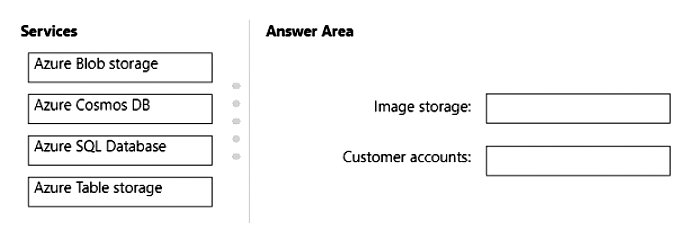
Correct Answer: 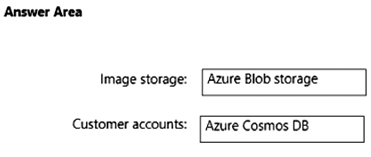
Question #25Topic 2
You are designing an application that will aggregate content for users.
You need to recommend a database solution for the application. The solution must meet the following requirements:
• Support SQL commands.
• Support multi-master writes.
• Guarantee low latency read operations.
What should you include in the recommendation?
- A. Azure Cosmos DB for NoSQL
- B. Azure SQL Database that uses active geo-replication
- C. Azure SQL Database Hyperscale
- D. Azure Cosmos DB for PostgreSQL
Correct Answer: A
Community vote distribution
A (100%)
Question #26Topic 2
You plan to migrate on-premises MySQL databases to Azure Database for MySQL Flexible Server.
You need to recommend a solution for the Azure Database for MySQL Flexible Server configuration. The solution must meet the following requirements:
• The databases must be accessible if a datacenter fails.
• Costs must be minimized.
Which compute tier should you recommend?
- A. Burstable
- B. General Purpose
- C. Memory Optimized
Correct Answer: A
Community vote distribution
B (91%)
9%
Question #27Topic 2
You are designing an app that will use Azure Cosmos DB to collate sales from multiple countries.
You need to recommend an API for the app. The solution must meet the following requirements:
• Support SQL queries.
• Support geo-replication.
• Store and access data relationally.
Which API should you recommend?
- A. Apache Cassandra
- B. PostgreSQL
- C. MongoDB
- D. NoSQL
Correct Answer: B
Community vote distribution
B (100%)
Question #28Topic 2
HOTSPOT
–
You have an app that generates 50,000 events daily.
You plan to stream the events to an Azure event hub and use Event Hubs Capture to implement cold path processing of the events. The output of Event Hubs Capture will be consumed by a reporting system.
You need to identify which type of Azure storage must be provisioned to support Event Hubs Capture, and which inbound data format the reporting system must support.
What should you identify? To answer, select the appropriate options in the answer area.
NOTE: Each correct selection is worth one point.
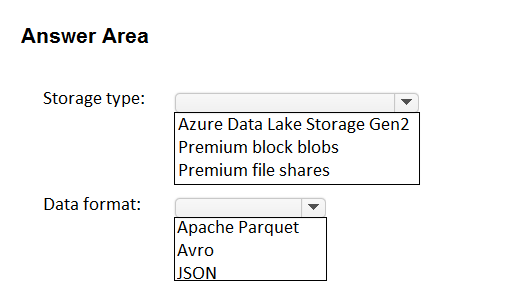
Correct Answer: 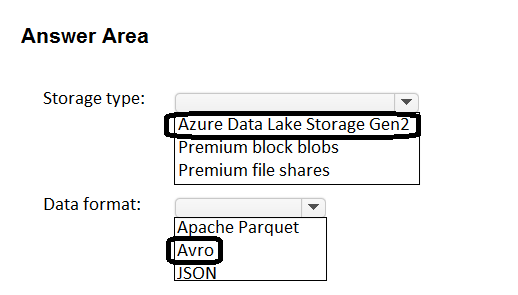
Question #29Topic 2
You have the resources shown in the following table.

CDB1 hosts a container that stores continuously updated operational data.
You are designing a solution that will use AS1 to analyze the operational data daily.
You need to recommend a solution to analyze the data without affecting the performance of the operational data store.
What should you include in the recommendation?
- A. Azure Data Factory with Azure Cosmos DB and Azure Synapse Analytics connectors
- B. Azure Synapse Analytics with PolyBase data loading
- C. Azure Synapse Link for Azure Cosmos DB
- D. Azure Cosmos DB change feed
Correct Answer: C
Community vote distribution
C (100%)
Question #30Topic 2
HOTSPOT
–
You have an Azure subscription. The subscription contains an Azure SQL managed instance that stores employee details, including social security numbers and phone numbers.
You need to configure the managed instance to meet the following requirements:
• The helpdesk team must see only the last four digits of an employee’s phone number.
• Cloud administrators must be prevented from seeing the employee’s social security numbers.
What should you enable for each column in the managed instance? To answer, select the appropriate options in the answer area.
NOTE: Each correct selection is worth one point.
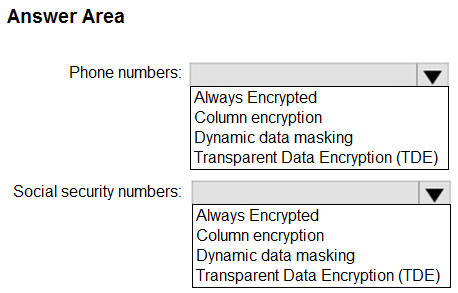
Correct Answer: 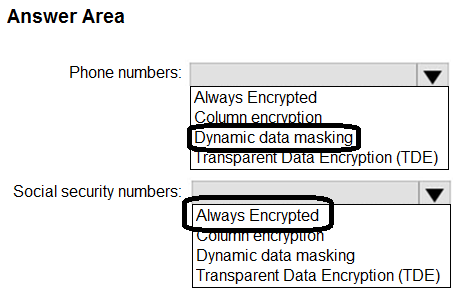
Question #31Topic 2
You plan to use an Azure Storage account to store data assets.
You need to recommend a solution that meets the following requirements:
• Supports immutable storage
• Disables anonymous access to the storage account
• Supports access control list (ACL)-based Azure AD permissions
What should you include in the recommendation?
- A. Azure Files
- B. Azure Data Lake Storage
- C. Azure NetApp Files
- D. Azure Blob Storage
Correct Answer: C
Community vote distribution
B (67%)
D (33%)
Question #32Topic 2
HOTSPOT
–
You are designing a storage solution that will ingest, store, and analyze petabytes (PBs) of structured, semi-structured, and unstructured text data. The analyzed data will be offloaded to Azure Data Lake Storage Gen2 for long-term retention.
You need to recommend a storage and analytics solution that meets the following requirements:
• Stores the processed data
• Provides interactive analytics
• Supports manual scaling, built-in autoscaling, and custom autoscaling
What should you include in the recommendation? To answer, select the appropriate options in the answer area.
NOTE: Each correct selection is worth one point.
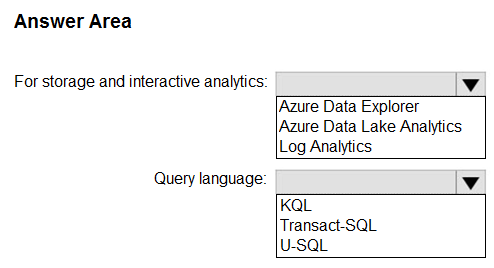
Correct Answer: 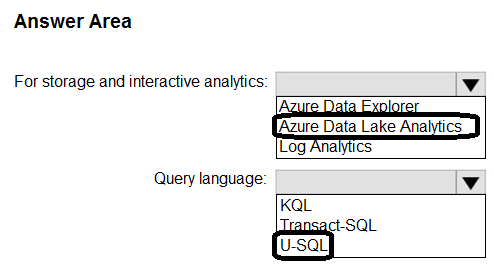
Question #33Topic 2
HOTSPOT
–
You plan to use Azure SQL as a database platform.
You need to recommend an Azure SQL product and service tier that meets the following requirements:
• Automatically scales compute resources based on the workload demand
• Provides per second billing
What should you recommend? To answer, select the appropriate options in the answer area.
NOTE: Each correct selection is worth one point.
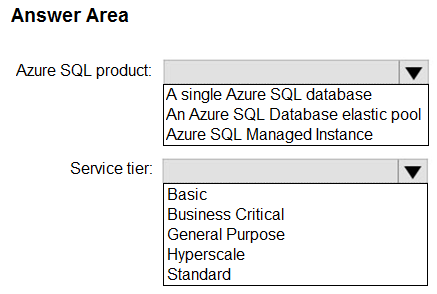
Correct Answer: 
Question #34Topic 2
HOTSPOT
–
You have an Azure subscription.
You need to deploy a solution that will provide point-in-time restore for blobs in storage accounts that have blob versioning and blob soft delete enabled.
Which type of blob should you create, and what should you enable for the accounts? To answer, select the appropriate options in the answer area.
NOTE: Each correct selection is worth one point.
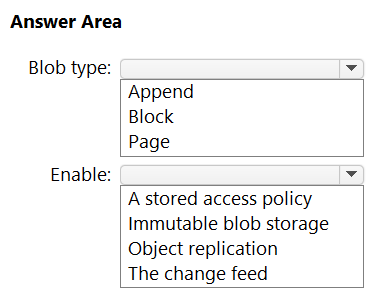
Correct Answer: 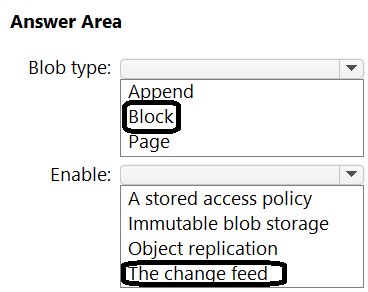
Question #35Topic 2
HOTSPOT
–
Your company, named Contoso, Ltd., has an Azure subscription that contains the following resources:
• An Azure Synapse Analytics workspace named contosoworkspace1
• An Azure Data Lake Storage account named contosolake1
• An Azure SQL database named contososql1
The product data of Contoso is copied from contososql1 to contosolake1.
Contoso has a partner company named Fabrikam Inc. Fabrikam has an Azure subscription that contains the following resources:
• A virtual machine named FabrikamVM1 that runs Microsoft SQL Server 2019
• An Azure Storage account named fabrikamsa1
Contoso plans to upload the research data on FabrikamVM1 to contosolake1. During the upload, the research data must be transformed to the data formats used by Contoso.
The data in contosolake1 will be analyzed by using contosoworkspace1.
You need to recommend a solution that meets the following requirements:
• Upload and transform the FabrikamVM1 research data.
• Provide Fabrikam with restricted access to snapshots of the data in contosoworkspace1.
What should you recommend for each requirement? To answer, select the appropriate options in the answer area.
NOTE: Each correct selection is worth one point.
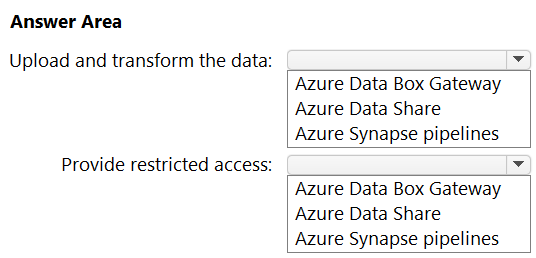
Correct Answer: 
Question #36Topic 2
HOTSPOT
–
You are designing a data pipeline that will integrate large amounts of data from multiple on-premises Microsoft SQL Server databases into an analytics platform in Azure. The pipeline will include the following actions:
• Database updates will be exported periodically into a staging area in Azure Blob storage.
• Data from the blob storage will be cleansed and transformed by using a highly parallelized load process.
• The transformed data will be loaded to a data warehouse.
• Each batch of updates will be used to refresh an online analytical processing (OLAP) model in a managed serving layer.
• The managed serving layer will be used by thousands of end users.
You need to implement the data warehouse and serving layers.
What should you use? To answer, select the appropriate options in the answer area.
NOTE: Each correct selection is worth one point.
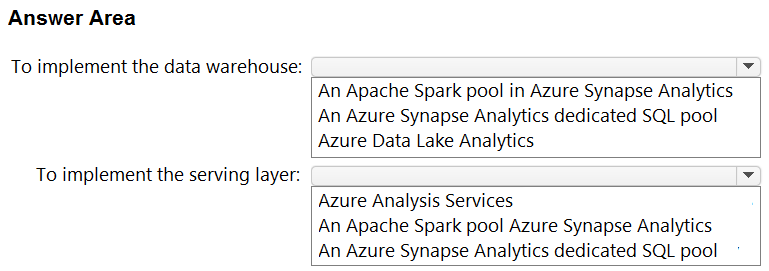
Correct Answer: 